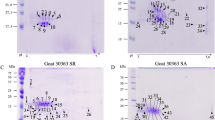Abstract
A peptide or a small protein released from an exocrine gland or in urine is utilized as a chemosignal that elicits social or reproductive behavior in mice. Recently, we identified the male-specific peptide, exocrine gland-secreting peptide 1 (ESP1), in mouse tear fluids that enhanced female sexual receptive behavior, and determined the three dimensional structure. ESP1 appears to be a member of multigene family that consists of 38 genes in mice, which we call the ESP family. ESP4, a member of the ESP family, is expressed in various exocrine glands, and shows the highest sequence similarity with ESP1. Here, we report the NMR assignments of ESP4 which provides a basis for NMR analyses of this protein. Our results will give insight into structural relationships within the ESP family.


Similar content being viewed by others
References
Brennan PA, Keverne EB (2004) Something in the air? New insights into mammalian pheromones. Curr Biol 14:R81–R89
Cavanagh J, Fairbrother WJ, Palmer AG III, Skelton NJ, Rance M (2007) Protein NMR spectroscopy: principles and practice. Academic Press, San Diego
Delaglio F, Grzesiek S, Vuister GW, Zhu G, Pfeifer J, Bax A (1995) NMRPipe: a multidimensional spectral processing system based on UNIX pipes. J Biomol NMR 6:277–293
Dulac C, Torello AT (2003) Molecular detection of pheromone signals in mammals: from genes to behaviour. Nat Rev Neurosci 4:551–562
Haga S, Kimoto H, Touhara K (2007) Molecular characterization of vomeronasal sensory neurons responding to a male-specific peptide in tear fluid: sexual communication in mice. Pure Appl Chem 79:775–783
Haga S, Hattori T, Sato T, Sato K, Matsuda S, Kobayakawa R, Sakano H, Yoshihara Y, Kikusui T, Touhara K (2010) The male mouse pheromone ESP1 enhances female sexual receptive behaviour through a specific vomeronasal receptor. Nature 466:118–122
Kimoto H, Haga S, Sato K, Touhara K (2005) Sex-specific peptides from exocrine glands stimulate mouse vomeronasal sensory neurons. Nature 437:898–901
Kimoto H, Sato K, Nodari F, Haga S, Holy TE, Touhara K (2007) Sex- and strain-specific expression and vomeronasal activity of mouse ESP family peptides. Curr Biol 17:1879–1884
Marsh JA, Singh VK, Jia Z, Forman-Kay JD (2006) Sensitivity of secondary structure propensities to sequence differences between alpha- and gamma-synuclein: implications for fibrillation. Protein Sci 15:2795–2804
Touhara K (2007) Molecular biology of peptide pheromone production and reception in mice. Adv Genet 59:147–171
Acknowledgments
We gratefully acknowledge H. Kimoto for helpful discussions. This work was supported by the Targeted Proteins Research Program (TPRP), and the Grants-in-Aid for Scientific Research on Priority Areas (19036022) from the Ministry of Education, Culture, Sports, Science and Technology, Japan, and by the Grants-in-Aid for Young Scientists (B) (24780104) and the Grants-in-Aid JSPS Fellows (222339) from the Japan Society for the Promotion of Science.
Author information
Authors and Affiliations
Corresponding author
Rights and permissions
About this article
Cite this article
Taniguchi, M., Yoshinaga, S., Haga-Yamanaka, S. et al. Backbone and side-chain 1H, 15N and 13C assignments of mouse peptide ESP4. Biomol NMR Assign 8, 7–9 (2014). https://doi.org/10.1007/s12104-012-9441-7
Received:
Accepted:
Published:
Issue Date:
DOI: https://doi.org/10.1007/s12104-012-9441-7




